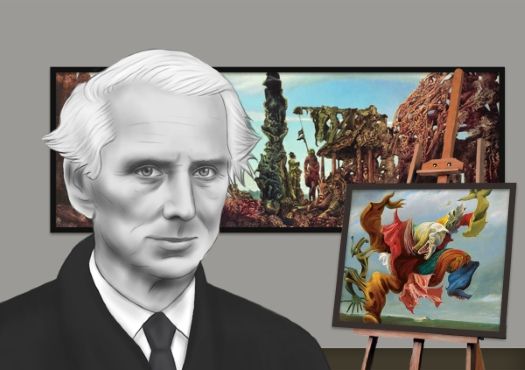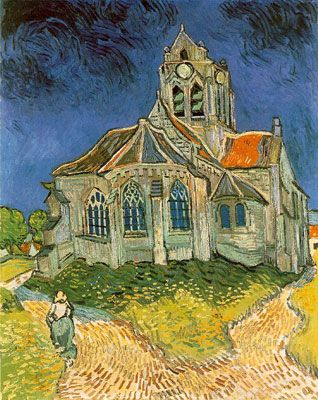Summary of Max Ernst
German-born Max Ernst was a provocateur, a shocking and innovative artist who mined his unconscious for dreamlike imagery that mocked social conventions. A soldier in World War I, Ernst emerged deeply traumatized and highly critical of western culture. These charged sentiments directly fed into his vision of the modern world as irrational, an idea that became the basis of his artwork. Ernst's artistic vision, along with his humor and verve come through strongly in his Dada and Surrealists works; Ernst was a pioneer of both movements. Spending the majority of his life in France, during WWII Ernst was categorized as an "enemy alien"; the United States government affixed the same label when Ernst arrived as a refugee. In later life, in addition to his prolific outpouring of paintings, sculpture, and works-on-paper, Ernst devoted much of his time to playing and studying chess which he revered as an art form. His work with the unconscious, his social commentary, and broad experimentation in both subject and technique remain influential.
Accomplishments
- Max Ernst attacked the conventions and traditions of art, all the while possessing a thorough knowledge of European art history. He questioned the sanctity of art by creating non-representational works without clear narratives, by making sport of religious icons, and by formulating new means of creating artworks to express the modern condition.
- Ernst was profoundly interested in the art of the mentally ill as a means to access primal emotion and unfettered creativity.
- Ernst was one of the first artists to apply Sigmund Freud's dream theories investigate his deep psyche in order to explore the source of his own creativity. While turning inwards unto himself, Ernst was also tapping into the universal unconscious with its common dream imagery.
- Interested in locating the origin of his own creativity, Ernst attempted to freely paint from his inner psyche and in an attempt to reach a pre-verbal state of being. Doing so unleashed his primal emotions and revealed his personal traumas, which then became the subject of his collages and paintings. This desire to paint from the sub-conscious, also known as automatic painting was central to his Surrealist works and would later influence the Abstract Expressionists.
Important Art by Max Ernst
Here Everything is Still Floating
This composition made from unrelated cutout photographs of fish, anatomical drawings, insects (turned over to suggest a sailing ship), and puffs of clouds and smoke cunningly arranged demonstrates Ernst's unique collage aesthetic. Through the medium, Ernst created a new world where randomness and illogic expressed the insanity of WWI and threw bourgeois sensibilities into question. The artist appropriated these images from scientific manuals, anthropological journals, and common merchandising catalogs dating from the turn-of-the-century. Ernst has managed to create a very delicate and detailed work, small in format, which seduces the viewer into close looking, and which propels the viewer to gauge the work's intentions. The title, Here Everything is Still Floating, does not appear to connect with the image in any meaningful way, except that the objects appear floating in the air. Despite the futile search for meaning, this whimsical work ultimately proves enjoyable and satisfying. The artist was to later recall that, "Collage was seen as a kind of crime, meaning one did violence to nature."
Cut-and-pasted printed paper and pencil on printed paper on cardstock - The Museum of Modern Art, New York
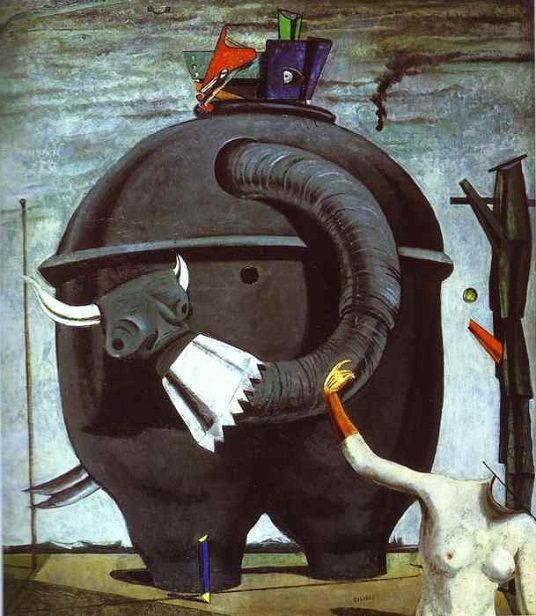
Celebes
At center, a large round shape dominates the composition that Ernst based upon a photograph of a Sudanese bin for storing corn which the artist has refigured as an elephant-like mechanical being from the subconscious. The painting's title (sometimes known as The Elephant Celebes) comes from a childish and naughty German rhyme that starts off, "The elephant from Celebes has sticky, yellow bottom grease," a bawdy reference to those that know the original rhyme.
Ernst's painting demonstrates his indebtedness to Freudian dream theory with its odd juxtapositions of disparate objects. Despite this disparity - a headless/nude woman, the bits of machinery - the painting holds together as a finished composition. Ernst's work elicits discomfort in the not knowing of his intentions and also, in early-20th century audiences, disgust because of its irrelevant depiction of the human form (the headless nude) which is revered within art making (since people are made in God's image). Through this work, Ernst questions which is the "real" world - that of night-time and dreams - or that of the waking state.
Oil on canvas - Collection of the Tate, United Kingdom
Ubu Imperator
This is a relatively small canvas in comparison to Ernst's other works although it radiates a commanding presence beyond its scale. At center, dominating the composition is a tower-like form with human arms extended and a head constructed as an architectural form. The tower is balanced precariously as if a spinning top which has been halted. The stability of architecture versus the instability of the tower's base, and its movement, places the object in internal conflict. Ernst has placed the body/building within a bare desert, with just an abandoned scythe in the background, which would prove futile in such a setting. The title, "Ubu Imperator," translates as the Commander, yet the central figure lacks the stability and authority a leader usually commands in both art and life.
Oil on canvas - Centre Georges Pompidou, Paris
Two Children Are Threatened by a Nightingale
A red wooden fence affixed to the painting's surface opens in a welcoming manner and reveals what at first seems to be an idyllic setting. Against a pleasing background of a blue sky, Ernst has diligently rendered a scene of confusion and terror. At top, a small figure strikes down on a buzzer as if to signal a warning. Our eye quickly catches sight of a crazed female figure at left running in distress - painted in grisaille -- wielding a knife as if fighting off the nightingale. A second female, similarly painted in just grey and white tones, collapses on the ground as if fainted. Ernst later provided two autobiographical references for the nightingale: first, was the death of his sister in 1897. The second was a boyhood fevered hallucination in which the wood grain of a panel near his bed took on "successively the aspect of an eye, a nose, a bird's head, a menacing nightingale, a spinning top and so on." Ernst would often depict birds in his works, which he used as an autobiographical symbol. Although Ernst painted from his own life and rendered personal symbols, he successful conveys the terror of dreams that is universal.
Oil on wood with painted wood elements and frame - The Museum of Modern Art, New York
The Virgin Spanking the Christ Child Before Three Witnesses: Andre Breton, Paul Eluard, and the Painter
Here, portrayed as an earthy, frustrated woman, the Virgin Mary sharply paddles her young son - the unruly baby Jesus - on his bottom which displays red marks already left by her punishing hand. Watching through the background window and serving as witnesses are Andre Breton, Paul Eluard, and the painter himself; all three seem untroubled by the scene. Ernst successfully upends both his own Catholic faith with its devotion to Christ's mother Mary, while simultaneously debasing much of Western art history with its proliferation of loving scenes between the Blessed Virgin Mary and the Christ child, and also, undercutting the secular, bourgeois sanctity of motherhood. Ernst's painting is simultaneously blasphemous and sharply humorous. As expected, not everyone saw humor in the theme and the work created considerable controversy as an attack on Christianity and contemporary values.
Oil on canvas - Museum Ludwig, Cologne
Forest and Dove
In this work, Ernst depicts a nocturnal scene of a forest of bizarre, abstract, and threatening trees. The artist frequently rendered thick forests to recall his own feelings and memories of "enchantment and terror" about the woods near his childhood home in Germany. Within this thick grove is a child-like drawing of a bird to represent Ernst, possibly in his post-war traumatic state. Forest and Dove exemplifies Ernst's pioneering 'grattage' technique where he scraped paint across the canvas to reveal imprints of objects, a technique he developed with the Spanish surrealist Joan Miro. Grattage produced a rough texture that added another dimension to the canvas - the density of a forest was amplified. It would be a mistake to overlook Ernst's German origins with its heritage of Romanticism, and how this shaped his individual psyche. The German concept of Ahnung, or the sense of foreboding, impending catastrophe pulsates in his apocalyptic paintings. Ernst was well-versed in Wagnerian myths of the German forests as being mysterious and spellbinding; the Surrealists later adopted forests and dark enclaves as a metaphor for the human imagination.
Oil on canvas - Collection of the Tate, United Kingdom
The Fireside Angel
This fantastical creature, with arms and legs extended, appears to be leaping with a garish, yet joyous, expression on its face. The figures and its appendages are oddly colored and malformed. Further, its leg seems to be spawning another being, as if a cancerous growth spreading. Fireside Angel is one of the rare works by Ernst that was inspired directly by world political events. The artist was motivated to paint the work after Franco's fascists defeated the Republicans in the Spanish Civil War. Ernst strove to create a painting suggestive of the ensuing chaos he feared was spreading across Europe, and emanating from his native Germany. Revisiting the benign and misleading title, it was Ernst's play to attract viewers with pleasing words, and then shock them into questioning their own beliefs by labeling monsters as angels.
Oil on canvas
Europe After the Rain II
In this other-worldly canvas, Ernst has painted an evocation of a vast apocalypse. In the midst of the ruined land, a helmeted, bird-headed figure - perhaps a soldier - threatens a female figure with his spear or ruined battle standard. It has been suggested that the figures could be large garden statuary, or perhaps semi-mythical survivors of a futuristic war. As mentioned previously, Ernst's use of the bird-human figure might be self-referential.
Seen within the context of 20th century European history, Europe after the Rain II bears testimony to the insurmountable reign of warfare that devastated Europe at the time. This work is unparalleled in Ernst's artistic interpretation of the Spanish Civil War and the beginnings of World War II. To create the ruinous forms, the grattage technique perfectly evokes the great destruction that Europe had suffered. The span of dates attributed to the work suggests that Ernst began this piece in France and completed it in the United States while the war continued on and the fate of Europe remained unknown.
Oil on canvas - Wadsworth Athenaeum Museum of Art, Hartford, Connecticut
The King Playing with the Queen
Among the mediums in which Ernst excelled was sculpture, such as in this prominent bronze. Similar to fellow Dadaist Marcel Duchamp, Ernst fancied chess playing as an art form unto itself. Ernst would often title his works with irrational titles, or tongue-in-cheek puns playing with words. Here, the enlarged king (most likely Ernst himself) plays with his diminutive queen (possibly his wife Dorothea Tanning) who herself is somewhat larger than the other pieces. The words "playing with" in the title might refer to sexual playing and games between the newlyweds, as well as the establishing of domestic order of married life.World War II was at its height in 1944 when Ernst along with Tanning spent the summer on Long Island as the guest of gallery owner Julien Levy; there, the couple often played chess. Ernst began a thorough examination into the intricacies of this game against the backdrop of global warfare. Earlier, in 1929, Ernst first modeled chess pieces that he turned into sculptures; he designed and executed several complete chessboards as well. Ernst's turn to chess as an artistic subject in the mid-1940s went beyond the technical merits of the game, instead probing what he thought were the game's literary and magical associations.
Bronze - The Museum of Modern Art, New York
Biography of Max Ernst
Childhood
Max Ernst was born into a middle-class Catholic family of nine children in Bruhl, Germany, near Cologne. Ernst first learned to paint from his father, a strict disciplinarian who was deaf, and a teacher who held an avid interest in academic art. A good deal of Ernst's work as an adult sought to undermine authority including that of his father. Other than this introduction to amateur painting at home, Ernst never received any formal training in art: thus he was responsible for his own artistic techniques. Ernst matriculated at the University of Bonn in 1914 to study philosophy but soon abandoned it, later claiming that he avoided "any studies which might degenerate into breadwinning." Instead, the artist preferred those areas of study considered "futile by his professors - predominately painting...seditious philosophers, and unorthodox poetry." At this time, Ernst became deeply interested in psychology and the art of the mentally ill. When World War I broke out Ernst was conscripted into the German army and served in an artillery division in which he directly experienced the drama and bloodshed of trench warfare - he served on both the Eastern and Western Fronts. Ernst was one of multiple artists who emerged from military service emotionally wounded and alienated from European traditions and conventional values.
Early Training
Although primarily self-taught, Ernst was influenced by the works of Vincent van Gogh and August Macke, and the canvases of Giorgio de Chirico prompted his interest in dream imagery and the fantastical. Ernst mined the experiences of his childhood and war to depict both absurd and apocalyptic scenes. A subversive tendency remained strong in Ernst throughout his career, as he literally turned the world upside down in many of his works. Returning to Germany after armistice, Ernst along with the artist-poet Jean Arp helped form the Dada group in Cologne; simultaneously he maintained close ties with the Parisian avant-garde. Ernst began creating his first collages in 1919, reworking mundane materials such as scientific manuals and illustrated catalogs from the turn-of-the-century to create new stunning, fantastical images without set narratives. This irrational image-making allowed Ernst to make the world of dreams, the subconscious, and the accidental all visual as he plumbed his own psyche for inspiration and to confront his own trauma.
Ernst edited journals while in Cologne and helped stage a Dada exhibition in a public restroom where visitors were greeted by a sweet young girl reciting obscene poetry. Also on view was a sculpture by Ernst with an axe alongside it that the public was invited to use to attack and to destroy the piece of art. This audience participatory event caused quite a scandal to bourgeois sensibilities.
Mature Period
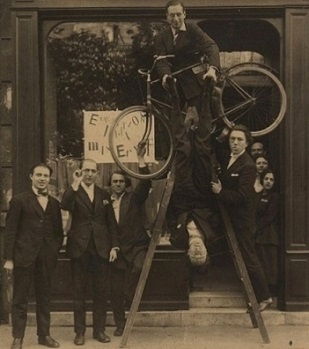
In 1922, Ernst left his first wife behind and moved to Paris, where he would live and work until 1941 - when World War II made it impossible to remain in Europe. During these decades, Surrealism came to displace Dadaism with the publication of André Breton's "First Surrealist Manifesto"(1924), and Ernst became one of the movement's founding members. Ernst and his artist-colleagues were discovering the possibilities of autonomism and dreams; in fact, his artistic investigations were aided by hypnosis and hallucinogenics. In 1925, in order to activate the flow of imagery from his unconscious, Ernst began to experiment with frottage (pencil rubbings of such things as wood grain, fabric, or leaves), a technique he in fact developed, and decalcomania (the technique of transferring paint from one surface to another by pressing the two surfaces together). His experiments and technical innovations led to finished images, accidental patterns, and definite textures which he would then incorporate into his drawings and paintings. This emphasis on the contact between materials, as well as transforming everyday materials in order to arrive at an image that signified some sort of collective consciousness, would become central to Surrealism's concept of automatism.
Late Years and Death
By 1933, Hitler and the Nazi Party had seized control of Germany. By the fall of 1937, Hitler had accumulated approximately sixteen-thousand works of avant-garde art from Germany's national museums, and shipped six hundred and fifty works to Munich to be for his infamous exhibition Entartete Kunst (Degenerate Art). It appears that Ernst had at least two paintings on display in the exhibition, both of which have since disappeared, or most likely were destroyed. Ernst fled from France with the Gestapo on his heels after being interned three times as a German national. As a refugee in New York where along with such important European avant-garde artists as Marcel Duchamp and Piet Mondrian, he electrified a generation of American artists. Ernst met Peggy Guggenheim, the flamboyant socialite, gallery owner, and patron of the arts, who was to become his third wife. Guggenheim provided Ernst entry to New York's burgeoning art scene.
Ernst's rejection of traditional painting techniques, styles, and imagery (as symbolized by the classical style of his father's work) captivated young American painters, who similarly sought to forge a fresh and unorthodox approach to painting. He had a particularly strong effect on the direction of Jackson Pollock's painting, who became interested in the collage aspects of Ernst's work, as well as his tendency to use his art as an externalization of his internal state. The younger artists were greatly interested in Ernst having captured the unconscious and the accidental in his art making, and his great Surrealist experimentation with autonomism and automatic writing. In 1942, Ernst experimented with "Oscillation" or painting by swinging a paint filled can punctured multiple times with holes over the canvas; this especially impressed Pollock.
Divorcing Guggenheim, Ernst soon relocated to Sedona, Arizona with his fourth wife, the American Surrealist painter Dorothea Tanning. Ernst and Tanning ultimately moved back to France in 1953. In 1954, Ernst was awarded the main painting prize at the prestigious Venice Biennale. In 1971, to honor the artist's 80th birthday, a major retrospective toured through America and Europe. Ernst was active as an artist up until his death in Paris in 1976. He was interred at Paris's famed Pere Lachaise Cemetery.
The Legacy of Max Ernst
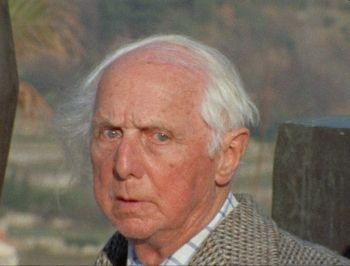
Max Ernst achieved a rare feat in that he established a glowing reputation and critical following in three countries simultaneously (Germany, France, and the United States) while still living. Although Ernst is an artist who is better known by art historians and academics than by the general public today, his influence in shaping the direction of mid-century American art is easily recognizable. Through his association with Peggy Guggenheim, Ernst interacted with the Abstract Expressionists directly, and via his son, Jimmy Ernst, who became a well-known German/American Abstract Expressionist painter after the war.
While based in Sedona, Ernst became attracted to Southwest Native American Navajo art as artistic inspiration. The younger Abstract Expressionists, in particular Pollock, in turn became fascinated with the art of sand painting, which are deeply tied to healing rituals and evocations of the spiritual. Ernst remains a foundational figure for those artists deeply interested in technique, psychology, and the desire to shock and confront social mores.
Influences and Connections

-
![Dorothea Tanning]() Dorothea Tanning
Dorothea Tanning -
![Peggy Guggenheim]() Peggy Guggenheim
Peggy Guggenheim ![Jimmy Ernst]() Jimmy Ernst
Jimmy Ernst
Useful Resources on Max Ernst
- Max Ernst: Life and WorkOur PickBy Werner Spies
- Max Ernst: Dream and RevolutionBy Werner Spies, Iris Muller-Westermann
- Max Ernst and Alchemy : A Magician in Search of MythBy Franklin Rosemont, M. E. Warlick
 Ask The Art Story AI
Ask The Art Story AI